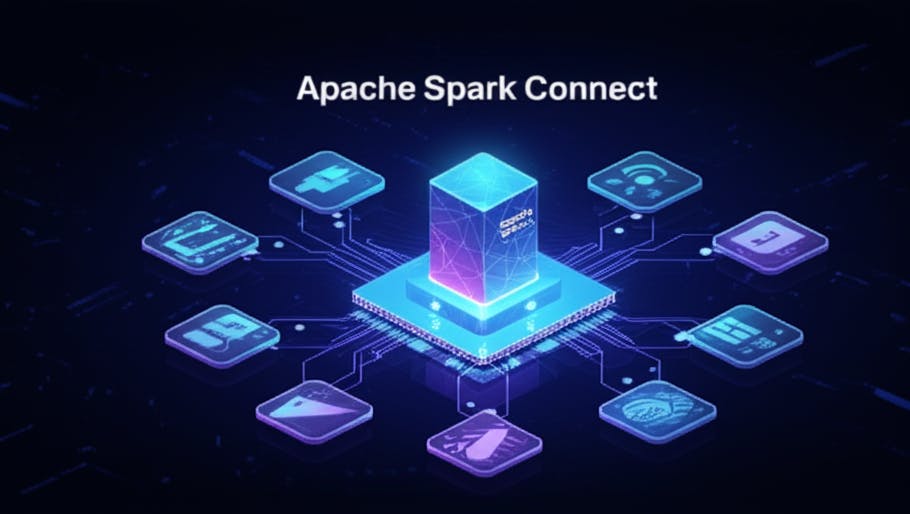Apache Spark has been a popular choice for large-scale distributed data processing. However, as data teams move to cloud architectures and separate computes from client interfaces, the traditional tightly coupled Spark driver model has begun to reveal its limitations. In this article we will explore the new Spark Connect feature, the future of the remote execution.
What is Spark Connect?
Spark Connect is a decoupled client-server protocol that lets Spark clients, like Python or Java applications, interact with a Spark driver process over the network. Unlike traditional Spark applications where the client starts and controls the driver, Spark Connect uses a gRPC-based protocol to communicate with a running Spark Connect server. Think of it as Spark as a Service for your data apps and notebooks.
Spark Connect is introduced in Spark 3.4 and further improved in 3.5. It changes how clients connect to and interact with a Spark cluster, providing more flexibility, scalability, and language support.
- Spark Connect is not a cluster manager. It's a protocol that allows clients to communicate with a Spark driver remotely, while still using traditional cluster modes underneath (like YARN or Kubernetes).
- Spark Connect makes client-side development easier and is ideal for integrating Spark into tools like VSCode, Jupyter, or web apps.
- Decoupling the client from the Spark cluster makes it easier to upgrade and scale the cluster separately from the client. This approach removes dependency conflicts and offers greater flexibility in language support.
Why Spark Connect?
Before Spark Connect, running a Spark application meant you had to combine the Spark driver with your client logic. This led to long startup times, dependency conflicts, and poor IDE integration. It was also difficult to use interactive notebooks or mobile/web-based interfaces with Spark backend.
With Spark Connect, clients are lightweight and only need a compatible client library. You can embed Spark inside VSCode, Jupyter notebooks, web apps, and mobile apps. This setup allows for easier scaling and faster iteration.
How does Spark Connect Work?
- A connection is established between the client and the Spark server.
- The client converts a DataFrame query into an unresolved logical plan, which describes what the operation should do, not how it should be executed.
- The unresolved logical plan is encoded and sent to the Spark server.
- The Spark server optimizes and executes the query.
- The Spark server sends the results back to the client.
Practical example: Using Spark Connect with PySpark
Step 1: Start the Spark Connect Server
# This launches the Spark Connect endpoint
$ ./bin/spark-connect-server
Step 2: Connect from a Python Client
from pyspark.sql import SparkSession
# sc:// is the special URI scheme used for Spark Connect
spark = SparkSession.builder.remote("sc://localhost:<PORT>").getOrCreate()
df = spark.read.csv("example.csv", header=True)
df.groupBy("category").count().show()
Best for the following use cases
- Interactive Data Science: Use Jupyter or VSCode to run Spark jobs remotely
- CI/CD Pipelines: Validate jobs in GitHub Actions or GitLab CI
- Remote Data Apps: Build APIs and dashboards powered by Spark
- Multi-Tenant Platforms: Serve multiple users via a single Spark backend
Limitations
- Spark Connect is still the early stages, so some features like complex UDFs or Streaming might have limited support.
- You need to upgrade to at least Spark 3.5+ for a more stable version.
- Monitoring and debugging are still developing for Spark Connect.
Spark Connect alternatives
Spark Job Server and Apache Livy are similar projects that expose Spark jobs through REST APIs. It is typically used to manage job submissions from external apps like dashboards and notebooks, enabling remote interaction with Spark. However, it differs fundamentally in design, use cases, and maturity.
|
Feature |
Spark Connect |
Spark Job Server |
Apache Livy |
|---|---|---|---|
|
Type |
Built-in gRPC client-server protocol |
External REST API server |
REST-based Spark session manager |
|
Official Status |
✅ Native to Apache Spark (3.4+) |
❌ Community project (not officially maintained) |
🟡 Incubating under Apache (inactive since 2021) |
|
Client Language Support |
Python, Scala, Java, Go, Rust, Dotnet |
REST only, language-agnostic |
REST + limited Scala/Python clients |
|
Architecture |
Lightweight clients + Spark driver over gRPC |
External server + job runners |
External service managing Spark sessions |
|
Latency / Interactivity |
⚡ Very low latency, interactive (DataFrame API) |
High (submit job, poll status) |
Medium-high |
|
Streaming Support |
❌ Limited (in progress) |
❌ No |
🟡 Partial (limited with batch-like APIs) |
|
Stateful Sessions |
✅ Persistent client-side SparkSession |
✅ Yes (Job Server Contexts) |
✅ Yes (Livy Sessions) |
|
Authentication / Security |
SSL/gRPC auth (evolving) |
Manual or custom |
Kerberos, Hadoop-compatible |
|
Ease of Deployment |
✅ Easy with Spark 3.5+ |
❌ Complex, often fragile |
❌ Tricky to deploy & scale |
|
Use Case Fit |
Interactive apps, notebooks, CI/CD |
Ad hoc job submission, dashboards |
Multi-user notebooks, REST access |
|
Extensibility / Maintenance |
✅ Actively developed |
❌ Unmaintained / legacy |
🟡 Outdated, low activity |
Conclusion
- Spark Connect is the future of remote Spark native interaction. It's fast and perfect for Developers, Notebooks, and Micro-services.
- Livy and Spark Job Server were temporary solutions before Spark had native client-server support. They work well for some REST API-based job orchestration scenarios but are now considered outdated and are not maintained.
- If you're starting a new project, go with Spark Connect. If you're maintaining an older system, Livy or Spark Job Server might still be useful for now.


